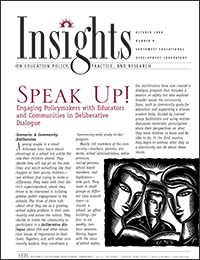Involving Parents and Community in the Schools
“Children make connections, and they make connections with whomever is involved. If the community is involved, then they’re going to make connections with that community.” Many educators would agree with this statement made by a kindergarten teacher who participated in a study circle program in Oklahoma. Educators and others education experts widely believe in the value of some level of parent and community involvement in education. The community can provide human, physical, and financial resources to help school children. Furthermore, parents are essential in the daily learning process of their children. Dialogue can be a doorway for community involvement in the work of educating children.
Children make connections, and they make connections with whomever is involved. If the community is involved, then they're going to make connections with that community.
Educators need the cooperation of the community to educate. Deliberative dialogue can help parents and neighbors of school children work with educators to understand and work with the unique, changing situations of their children and youth. Investigations of the changing face of America’s young people reveals, in particular, an increasingly diverse student population, many of whom come from language and cultural backgrounds not previously represented in some schools (Ashby, Garza, & Rivas, 1998). Furthermore, many children live in difficult personal situations and come to school hungry, tired, or in poor health. If teachers and other school personnel are to make informed decisions regarding the day-to-day teaching and learning environment for all children, they need the information and cooperation other community members can offer. The kindergarten teacher above stressed that her primary concern each day is meeting the needs of the children in the classroom-children who come to school with diverse backgrounds and experiences. After trying to meet their basic needs in addition to their basic education, she welcomes the perspectives of fellow community members familiar with these children and values the opportunity to engage the community in helping meet those needs.
Together, dialogue participants can design creative solutions for education problems. Some education issues persist despite every effort to resolve them. Often neither educators nor policymakers have the professional freedom or detachment to try new approaches to old problems. The research they have read or experiences they have had, although very valuable, may keep them settled into certain ways of thinking, making it difficult for them to conceive of other options and viewpoints. The public can offer a fresh, practical perspective on these persistent problems and concerns in education. Involving the public permits an innovative reconsideration of the issues that policymakers or educators see as “cut and dried” (Briand, 1995).
Combining the thinking of diverse educators, policymakers, and the public in a structured, facilitated deliberative dialogue has the added potential of generating group ideas that would not arise absent the interaction. People with fresh ideas but limited knowledge about school realities may expand their perspectives by talking with educators and working with these professionals to brainstorm innovations. Conversely, educators may be better able to open their minds and think “outside the box” after hearing other thoughts and ideas. Policymakers may see new ways to overcome policy obstacles. Collectively, participants can build on each other’s ideas and find a common ground among them in the process.
The public can offer a fresh, practical perspective on these persistent problems and concerns in education.
In addition to their support and ideas, non-educators in the community have many tangible resources they can contribute to schools. Engaging parents and community members in deliberative dialogue about education can serve as an introduction to the schools for those who, for various reasons, have stayed away or have not seen an opportunity to get involved. Some parents’ only contact with the school is in relation to a problem with their child. Others have not set foot in a school since they were students themselves or since their children were very small. An inclusive dialogue program can be effective in engaging people from the community and exposing them to school practices, challenges, and successes. Long after the dialogue has ended, community members can become involved in helping schools by volunteering, contributing to funds and fund raising efforts, participating in extra curricular activities, and working with their own children on schoolwork outside of school.
All willing members of the community need to contribute to the dialogue regarding what and how students should learn. These include taxpayers who fund schools and vote for bonds; policymakers and administrators who shape education for the community; the business community who will receive students into the workforce; and educators, parents, and students, including home schoolers and private school representatives, who directly engage in the day-to-day work of education. Not only do they each have a valuable stake in what children know and are able to do as a result of education, but they can each play a part in the effectiveness of education policies and practices. The deliberative dialogue process can help establish a supportive environment for discussing education and build collaborative relationships among decision makers, educators, and non-educators.
Next Page: Implementation Issues to Consider

